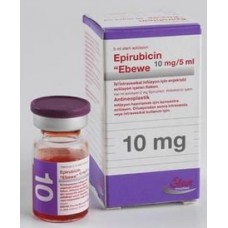Expiration date: 01/2026
Pharmacological action
Antitumor drug from the group of synthetic anthracycline antibiotics. Quickly penetrates into the cells, localized mainly in the nucleus. At the molecular level, epirubicin can form a complex with DNA by intercalation between the main nucleotide pairs, which leads to disruption of the synthesis of DNA, RNA and proteins. Intercalation in DNA is the trigger of DNA cleavage under the action of topoisomerase II, leading to serious violations in the tertiary structure of DNA. Epirubicin (as doxorubicin) may be involved in oxidation/reduction reactions with the formation of highly active and highly toxic free radicals.
Indications
- transitional cell bladder cancer,
- breast cancer,
- cancer of the stomach and esophagus,
- head and neck cancer,
- primary hepatocellular cancer,
- acute leukemia,
- non-small cell and small cell lung cancer,
- non-Hodgkin's lymphoma.,
- hodgkin,
- myeloma,
- ovarian cancer,
- pancreatic cancer,
- prostate cancer,
- rectal cancer,
- soft tissue sarcoma,
- osteosarcoma.
Contraindications
- hypersensitivity to the preparation components and other anthracyclines or anthracenediones,
- pregnancy,
- lactation (breastfeeding).
For I/V introduction
- severe myelosuppression,
- expressed violations of liver function,
- severe heart failure,
- arrhythmias,
- recent myocardial infarction,
- prior therapy with cumulative doses of anthracyclines or anthracenediones.
For injection into the bladder
- invasive tumors with penetration into the bladder wall,
- urinary tract infections,
- inflammation of the bladder.
Overdose
Symptoms: severe myelosuppression (mainly leukopenia and thrombocytopenia), toxic manifestations from the gastrointestinal tract (mucositis), acute complications from the heart.
Treatment: symptomatic therapy. The antidote to epirubicin is unknown.
Method of application
The drug is used as monotherapy, and in combination with other cytostatics in different doses, depending on the therapy regimen. When choosing an individual dose should be guided by the data of the literature.
When/in the introduction as monotherapy recommended standard dose per cycle for adults is 60-90 mg / m2 every 3-4 weeks. The total dose of the drug per cycle can be administered both simultaneously and divided into several injections for 2-3 days in a row.
If the drug is used in combination with other anticancer drugs, the recommended dose per cycle should be reduced accordingly.
In some cases, the drug can be used in higher doses of 90-120 mg/m2 once at intervals of 3-4 weeks.
Repeated administration of the drug is possible only with the disappearance of all signs of toxicity (especially hematological and gastrointestinal).
Patients with impaired renal function and serum creatinine levels of more than 5 mg/DL should be prescribed in reduced doses.
In patients with impaired liver function, if the concentration of bilirubin in serum is 1.2-3 mg / DL or AST value 2-4 times higher than the upper limit of the norm, the administered dose should be reduced by 50% of the recommended. If the concentration of bilirubin in serum more than 3 mg / DL or AST value exceeds VGN more than 4 times, the dose should be reduced by 75% of the recommended.
Patients who have previously received massive anticancer therapy, as well as tumor infiltration of the bone marrow, it is recommended to prescribe the drug in lower doses or to increase the interval between cycles.
In elderly patients during the initial therapy may use standard doses and regimens.
To reduce the risk of thrombosis and extravasation, Pharmorubicin is recommended to be administered through a system tube for in / infusion during drip administration of 0.9% sodium chloride solution or 5% glucose solution. The duration of infusion should be from 3 to 20 minutes, depending on the dose and volume of the infusion solution.
For the treatment of superficial bladder tumors, it is recommended to carry out 8 weekly instillations of the drug in the bladder at a dose of 50 mg (dissolved in 25-50 ml of saline). If you have symptoms of a local toxic effect (chemical cystitis manifested by dysuria, polyuria, nocturia, painful urination, hematuria, discomfort in the bladder, necrosis of the bladder wall), the dose should be reduced to 30 mg.
In the treatment of bladder cancer in situ, depending on individual tolerability, the dose of the drug can be increased to 80 mg.
To prevent recurrence after transurethral resection of superficial tumors, it is recommended to perform 4 weekly instillations of 50 mg, followed by 11 monthly instillations in the same dose.
Farmorubicin instant should instilliruut through the catheter and leave it inside the bladder for 1 h. During instillation, the patient should roll over, to ensure uniform exposure of the solution to the mucous membrane of the bladder. To prevent excessive dilution of the drug with urine, the patient should be warned about the need to refrain from drinking for 12 hours before instillation. At the end of the instillation procedure, the patient must empty the bladder.
Particular attention should be paid to problems associated with catheterization (including obstruction of the urethra due to massive intravesical tumors).
In hepatocellular cancer to provide intensive local exposure and while reducing the overall toxic effect of pharmorubicin, rapidly soluble Can be injected intraarterially into the main hepatic artery at a dose of 60-90 mg/m2 with an interval of 3 weeks to 3 months or at doses of 40-60 mg/m2 with an interval of 4 weeks.



